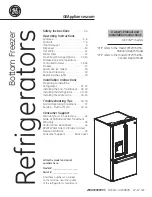
9
INSTAllATION
iNitiAL StARt-Up
8 . When you have the appliance in its final position, it
needs to be stablisied . Wind the stability foot down
to the floor until it just makes contact with the floor. Lift
the front of the appliance to take the weight off the
stability foot, then turn it ¼ turn further to ensure firm
contact with the floor. Whenever you need to move the
appliance, be sure to wind the foot back up so that the
appliance can roll freely and be sure to reset it when
reinstalling .
9 . Clean your refrigerator thoroughly following the
instructions on page 16 and wipe off any dust that has
accumulated during shipping .
10. Plug your refrigerator straight into its own power point
and never use a double adapter . If you need to roll the
refrigerator to get to the plug, remember to raise the
stability foot first .
11. Before you put any food in your refrigerator, it’s
recommended you leave it on for 2 or 3 hours to check
it is running properly .
Congratulations! You have successfully installed your new
refrigerator .
Refrigerators work by transferring heat from the food inside
to the outside air . This operation makes the back and sides
of the refrigerator (particularly at start-up) feel warm – which
is normal .
A cooling coil is located behind the rear wall of the freezer
section (in top mount, bottom mount and freezer models)
and behind the crisper in the all-refrigerator models .
This coil cools and removes moisture from the air inside .
Avoid placing food against the air vents in the refrigerator,
as it affects the efficient circulation . If the door is opened
frequently, a light frosting will occasionally occur on the
freezer’s interior. This is normal and will clear after a few
days . If the freezer door is accidentally kept open, a heavy
frost will coat the inside walls and should be removed .
Your new refrigerator uses a high-speed compressor,
along with other energy-efficient components, which may
make unusual sounds . These sounds simply indicate your
refrigerator is working how it should . They include:
• Compressor running noises;
• Air movement noise from the small fan motor;
• A gurgling sound, similar to water boiling;
• A popping noise, heard during automatic defrosting;
and
• A clicking noise, prior to compressor start-up.
Further details can be found on page 17 .
TIPS & INFORMATION
TIpS AND INfORMATION
• For top mount refrigerators. (Where the freezer is on top
of the fresh food compartment)
– Don’t place food forward of the ribs on the freezer
floor, as it will keep the door open.
• For bottom mount refrigerators (where the freezer is below
the fresh food compartment), single door refrigerators and
single door vertical freezers .
– Ensure all freezer drawers and shelves are pushed
back completely to prevent them from keeping the
door open .
Sensor
Ribs
Air vents
Stabilising foot
wound down
side view
front view






































